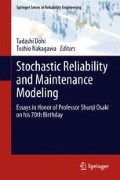Abstract
In this chapter, we propose a procedure for implementing customer-perceived software reliability predictions, which address customer’s concern about service-impacting outages and system stability. Data requirements are clearly defined in terms of test defects and field outages to ensure a good data collection process. We incorporate the effect of operational profile to demonstrate the changes in defect find rate from internal tests through precutover test and in-service operation. A software reliability growth model is a necessary key step, but not sufficient for addressing customer-perceived reliability measures. The proposed approach is a result of in-depth investigations of test defect data and field outage data over many years. It has been successfully demonstrated with actual field data and applied to a variety of software development projects.
Access this chapter
Tax calculation will be finalised at checkout
Purchases are for personal use only
References
Goel AL, Okumoto K (1979) Time-dependent error-detection rate model for software reliability and other performance measures. IEEE Trans Reliab 206–211
Jelinski Z, Moranda PB (1972) Software reliability research. In: Feiberger W (ed) Statistical computer performance evaluation. Academic, New York, pp 465–484
Jeske DR, Zhang X, Pham L (2005) Adjusting software failure rates that are estimated from test data. IEEE Trans Reliab 107–114
Lyu MR (1995) Handbook of Software Reliability Engineering. Computer Society Press, McGraw-Hill, Los Alamitos, New York
Musa JD (1993) Operational profiles in software-reliability engineering. IEEE Softw 14–32
Musa JD, Iannino A, Okumoto K (1987) Software Reliability: Measurement, Prediction, Application. McGraw-Hill, New York
Okamura H, Dohi T, Osaki S (2001) A reliability assessment method for software products in operational phase—proposal of an accelerated life testing model. Electron Commun Japan 25–33
Okumoto K (2010) Software reliability predictions—Are we done yet? QuEST Americas best practices conference, Atlanta, GA
QuEST Forum’s TL 9000 (2007) Measurements Handbook Release 4.0
Schick GJ, Wolverton RW (1973) Assessment of software reliability. In: Proceedings of operations research, Physica-Verlag, Wurzburg-Wien, pp 395–422
Schneidewind NF (1975) Analysis of error processes in computer software. In: Proceedings of the international conference on reliable software, IEEE Computer Society, pp 337–346
Wallace D, Coleman C (2001) Application and improvement of software reliability models. Hardware and software reliability. Software Assurance Technology Center (SATC), pp 323–08
Yamada S, Ohba M, Osaki S (1983) S-shaped reliability growth modeling for software error detection. IEEE Trans Reliab 475–478
Zhang X, Pham H (2006) Software field failure rate prediction before software deployment. J Syst Softw 291–300
Acknowledgments
I am deeply honored and grateful to Professor Shunji Osaki (then at Hiroshima University, Japan) for his guidance and support throughout my professional career. He provided me the opportunity to pursue my graduate degree under Professor Amrit Goel at Syracuse University, NY. Professor Goel not only supported my Ph. D. program but also introduced me to new research in software reliability, which was supported by the Rome Air Force Development Center. It was my pleasure working with John Musa at Bell Labs in Whippany, NJ, including our coauthored book. He was instrumental in developing a software reliability engineering program. My special thanks to Doris Ryan, Ken Ng, and Heather Brown at Alcatel-Lucent Technologies for their management support and constructive feedback over the last decade. Their guidance and directions have been extremely helpful for applying the software quality/reliability approach to various projects.
Author information
Authors and Affiliations
Corresponding author
Editor information
Editors and Affiliations
Appendix A: Derivation of Maximum Likelihood Estimates for an Exponential Model
Appendix A: Derivation of Maximum Likelihood Estimates for an Exponential Model
In this section, we will consider a case where defect data are available on a grouped basis such as weekly. The equations for deriving estimates of a and b for an exponential model will be provided using the maximum likelihood estimation method. Additional details are available from Musa et al. [6].
Let \(y_{i}(i = 1, \ldots , p)\) be the number of defects found in \((0, x_{i})\). Then the likelihood function of a and b, given the defect data set \(y_{i}(i = 1, \ldots , p)\), is derived from (1) as:
where \(x_{0 }=y_{0}= 0\), and, the mean value function m(t) is given by (2). After some algebra by taking partial derivatives of the log-likelihood function of (A.1) with respect to a and b and setting to zeros, we have the following two equations:
and
where \(\text{ A }_{i}, \text{ B }_{i}\), and C are, respectively, given by:
Maximum likelihood estimates of a and b can be obtained by solving Eqs. (A.2) and (A.3). Note that Eq. (A.2) implies a and b satisfy the last data point \((x_{p}, y_{p})\). That is, the mean value function with the maximum likelihood estimates of a and b always goes through the first data point \((x_{0 }, y_{0})\) and last data points point \((x_{p}, y_{p})\). It should be pointed out that Eq. (A.3) is nonlinear but can be easily implemented in a spreadsheet with the use of a built-in function such as “solver”.
In order to obtain confidence intervals for a and b, we take a second derivative with respect to b and substitute the estimate of b into the negative of the second derivative. Since the inverse of the above quantity is considered as the variance of estimate b, the 90 % confidence interval for b can be constructed using a normal approximation. The 90 % confidence interval for a can be obtained using (A.2) for each limit of b.
Rights and permissions
Copyright information
© 2013 Springer-Verlag London
About this chapter
Cite this chapter
Okumoto, K. (2013). Customer-Perceived Software Reliability Predictions: Beyond Defect Prediction Models. In: Dohi, T., Nakagawa, T. (eds) Stochastic Reliability and Maintenance Modeling. Springer Series in Reliability Engineering, vol 9. Springer, London. https://doi.org/10.1007/978-1-4471-4971-2_11
Download citation
DOI: https://doi.org/10.1007/978-1-4471-4971-2_11
Published:
Publisher Name: Springer, London
Print ISBN: 978-1-4471-4970-5
Online ISBN: 978-1-4471-4971-2
eBook Packages: EngineeringEngineering (R0)

